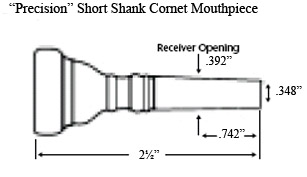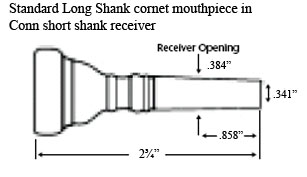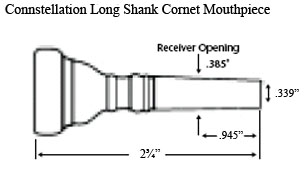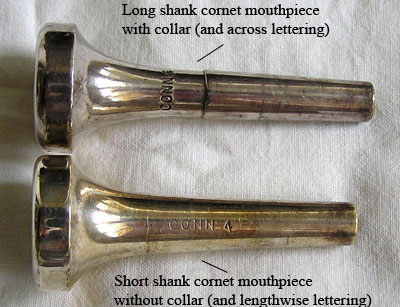The short and long of cornet mouthpieces
Introduction
Sorry for the corny title, I couldn't resist.
In 1958 Conn switched its cornets and cornet mouthpieces from so-called "short shank" cornet mouthpieces to
"long shank" cornet mouthpieces. I have recently had the opportunity to explore the differences and the effect
of playing a short shank cornet with a long shank mouthpiece on the one hand and a proper short shank mouthpiece
on the other hand. In this article I will discuss my findings. NOTE: Please see the paragraph "addendum" at the
end of this article for updated information.
Conn's cornet changeover
Prior to 1958, all Conn cornets and all Conn cornet mouthpieces were of the "short shank" variety, although you
won't find them named that way in the Conn literature of the time. This means that all Conn cornets with serial
numbers less than 700,000 were designed to take a short shank cornet mouthpiece. Conn cornets produced between 1955
and 1957, with serials between 500,000 and 699,999 may have been designed to take long shank mouthpieces as well.
Tests with my 1956 10A Victor would
indicate that it likes the short shank mouthpiece better. Conn cornets produced from 1958 on, serial numbers 700,000
and higher, were designed to take long shank mouthpieces only.
These days when you buy a cornet mouthpiece it almost invariably is a long shank mouthpiece. So what happens when you put one of those long shank cornet mouthpieces on a cornet that wasn't designed to accept one? Recently (May 2006) I had the opportunity to find out.
The test subject
In May 2006 I bought a 1936 Conn 38A Victor cornet. This instrument was not in very good shape: it appeared that
at some point it had fallen to the floor, mouthpiece first. As a result the (original) short shank mouthpiece
was stuck in the receiver and the leadpipe bent down. Presumably frustrated, the owner put it in the cupboard and
forgot about it for several decades.
When I got it I took the cornet to the repair people. They succeeded in extracting the mouthpiece (intact), bending the leadpipe straight and unfreezing the slides. I have played this cornet with both a short shank Conn 6 cornet mouthpiece I had and my usual (long shank) Connstellation 5CW cornet mouthpiece. The short shank Conn 6 fits and plays quite a bit better than the long shank Connstellation 5CW. The Conn 6 fits like a glove, the 5CW "wobbles" a bit. Also, while the Conn 6 is nice and open, the long shank 5CW feels a bit stuffy.
My thinking on that is this: Having an original short shank mouthpiece stuck in the receiver for such a long time has "protected" the receiver from long shank mouthpieces: it hasn't been reamed out to the shape of the long shank mouthpiece. I suspect that many pre-1955 short shank cornets have had their receivers reamed out by frequent use of improperly fitting long shank cornet mouthpieces. So, this is a good test case instrument.
Sizing up the mouthpieces
I went ahead and with my digital calipers accurately measured both a short shank and a long shank cornet mouthpiece.
The results are in these two diagrams (modified from a Bach publication):


As you can see, the short shank mouthpiece is an overall ¼" shorter than the long shank mouthpiece. More importantly to us, are the differences in the receiver opening and the insertion length: the short shank has an insertion length of 0.742" with a receiver opening of 0.392", while the long shank mouthpiece has a insertion length of 0.875" and a receiver opening of 0.385". So what happens when you insert a long shank mouthpiece into a short shank receiver:

What this shows us is this: The long shank mouthpiece will sink into the short shank receiver up to the point that the receiver narrows down to 0.341", which is about 0.858" down. At that point the width (receiver opening) of the long shank mouthpiece is 0.384", which is 0.008" less than it is supposed to be for a short shank receiver. As little as it may seem to be, it is enough to cause an improperly fitting mouthpiece.
In the spring of 2007 I had Kanstul make me a shank that was a copy of a Conn 4 short shank cornet. Kanstul's Jim New said this about it: "The taper is in fact different, we measure 0.06" per inch where a standard taper is 0.05" per inch." In other words, Conn short shank cornet mouthpieces are indeed more tapered than long shank cornet mouthpieces.
Beware that while modern short shank mouthpieces might be the right length (2½"), they might not be the right taper. I have not had the chance to measure one, but a modern short shank cornet mouthpiece, while better than a long shank cornet mouthpiece, might still not properly fit a pre-1958 Conn corner.
Constellation long shank cornet mouthpiece
Interestingly, the Connstellation cornet mouthpieces, which are long shank mouthpieces with a taper of 0.05" per inch, are nevertheless
configured a bit differently.

As is visible in this diagram, the tip opening is a bit narrower than a standard specification long shank cornet mouthpiece. Consequently, it inserts a bit deeper into the receiver of a correct long shank cornet (in this case, a 1960 10A Artist). When a Connstellation cornet mouthpiece is inserted into a short shank receiver, it sits to a depth of about 0.932" with a receiver opening of 0.386". This means it has less of a gap at the receiver opening than a standard long shank mouthpiece in a short shank receiver (but still not recommended; the test I described earlier with my 1956 10A and a long shank cornet mouthpiece was done with a Connstellation 5CW).
Conclusions
From this we can reach a few tentative conclusions:
1. If your long shank cornet mouthpiece fits perfectly in your short shank cornet, it has probably been reamed out.
2. Do try a short shank mouthpiece on your pre-1958 Conn cornet; chances are good it will play better.
How to recognize Conn's short shank cornet mouthpiece?
The easiest way to tell the difference between a Conn long shank and a Conn short shank mouthpiece isn't that difficult to spot: The long shank
models all have a "collar" around the shank, while the short shank mouthpiece don't.

Addendum
It has come to my attention that Conn cornet mouthpiece of a style older than the art-deco style mouthpieces pictured above
are often even shorter than so-called "short shank" cornet mouthpieces. While the "short shank" cornet mouthpieces are 2½" long,
a Conn "Wonder" mouthpiece (turn of the century) was measured at 2 1/3". Terminology wise it makes things rather confusing. I suspect the
change from these mouthpieces to the "short shank" discussed here (which are then in fact longer than the "turn of the century" models)
may have occured sometime in the early 1930's. I will need to do more research into this.